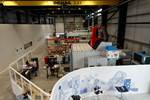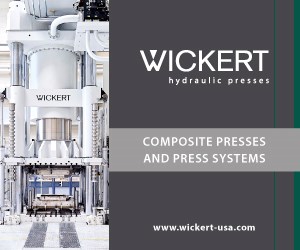Bio-based composite bridge in The Netherlands
This summer, FiberCore Europe joined forces with TU Delft and Schiphol Logistics Park, and other firms and local agencies, on the design and construction of an ecologically sustainable composite footbridge made with bio-based materials.
This summer, FiberCore Europe (Rotterdam, The Netherlands) joined forces with TU Delft (Delft, The Netherlands) and Schiphol Logistics Park (Schiphol, The Netherlands), and other firms and local agencies, on the design and construction of an ecologically sustainable composite footbridge made with bio-based materials. The bridge is located at the logistics business park in the Dutch city of Rozenburg.
For his thesis at the Bridge Design Group of TU Delft, architect Rafail Gkaidatzis researched bridge designs incorporating the highest proportion of bio-based materials possible. He calls his resultant design “bio-basalt balsa,” or B3. The 15m-long, 2m-wide bridge spans the waterway between the Ringdijkpark and the Naritaweg at Schiphol Logistics Park and is publicly accessible by employees of the business park and residents of the adjacent Aalsmeerderdijk neighborhood.
The bridge elements combine basalt fibers from Mafic (Kells, Ireland) and a bio-based polyester resin, based on glycerine-derived glycol. The deck is cored with Baltek balsa supplied by Airex AG, a division of 3A Composites (Sins, Switzerland). Advantages of the composite construction compared to traditional materials are its high strength, low energy requirement during construction, low maintenance requirement and long service life, with no rot or corrosion. As a result, the bridge material is expected to last for at least 100 years.
FiberCore Europe says that the combination of materials, never before used in bridge construction, makes the project unique. It’s a step toward making civil construction more sustainable and contributes to the realization of a sustainable society.
The sustainable bridge is the result of the excellent cooperation of all parties involved. Not only technical challenges were overcome, but directors, funders and the client also showed the courage to realize this innovation in deviation from standard procedures.
Related Content
-
Watch: A practical view of sustainability in composites product development
Markus Beer of Forward Engineering addresses definitions of sustainability, how to approach sustainability goals, the role of life cycle analysis (LCA) and social, environmental and governmental driving forces. Watch his “CW Tech Days: Sustainability” presentation.
-
Plant tour: Middle River Aerostructure Systems, Baltimore, Md., U.S.
The historic Martin Aircraft factory is advancing digitized automation for more sustainable production of composite aerostructures.
-
Recycling hydrogen tanks to produce automotive structural components
Voith Composites and partners develop recycling solutions for hydrogen storage tanks and manufacturing methods to produce automotive parts from the recycled materials.
















